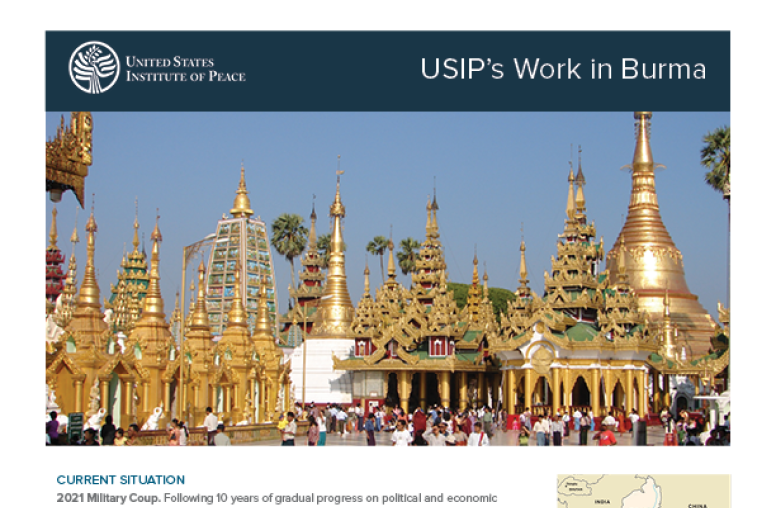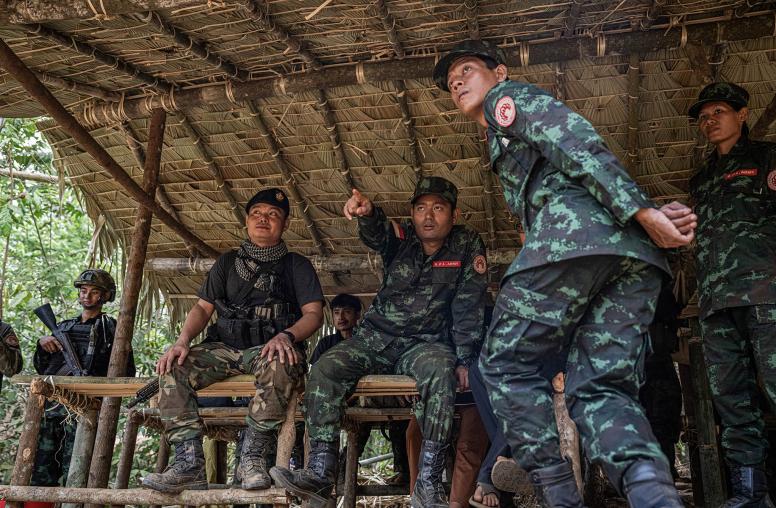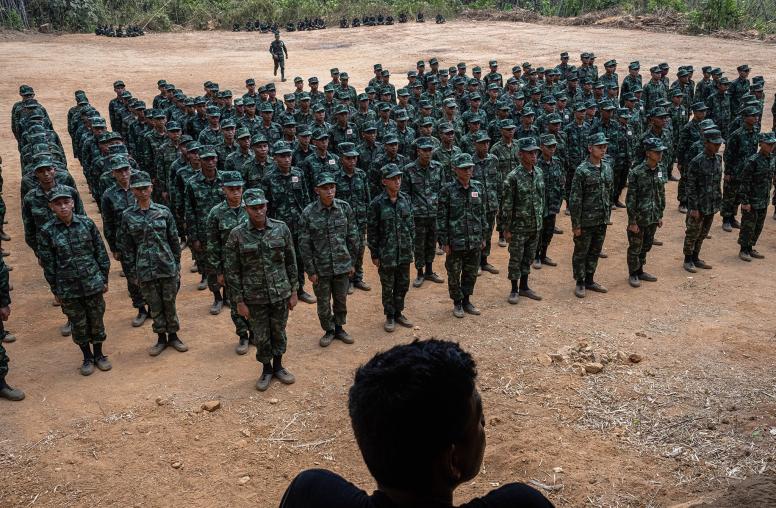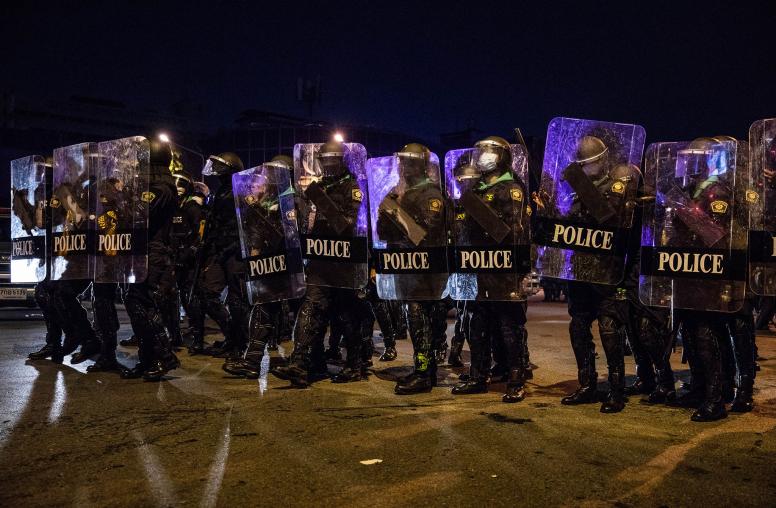From Pariah to Partner: The US Integrated Reform Mission in Burma
Case Study: Defense, Development and Diplomatic (“3D”) Learning from Complex Crisis
This series of case studies—Burma (2009-2015), Jordan (2011-2016), and the Lake Chad Region (2013-2016)—document efforts and draw lessons from where US government leaders believe deepening crises were staved off through collaborative inter-agency engagement. Part of USIP’s “3D Learning from Complex Crises” project, the cases provide programmatic and operational lessons from complex operating environments. These lessons support systemic integrated approaches to complex crises and will better equip individuals to share objectives when working in inter-agency environments.
Case Background
Burma is an example of a state transitioning to democratic governance after decades of military rule and unresolved ethnic conflicts. Disaster-prone and strategically located, Burma has attracted attention from Western and Eastern countries vying for influence within its borders.
In the wake of the 2007 Saffron Revolution, catastrophic Cyclone Nargis in 2008, and a subsequent constitutional referendum, elements within Burma’s ruling military junta began to consider having closer ties with the United States. Despite the junta’s human rights abuses and undemocratic actions, in 2009 the United States began to open the door to engagement with Burma to foster the country’s political and economic transition. This step had national security implications, because Burma is strategically located between China and India, and was developing closer military ties to North Korea, making Burma a nuclear proliferation risk.
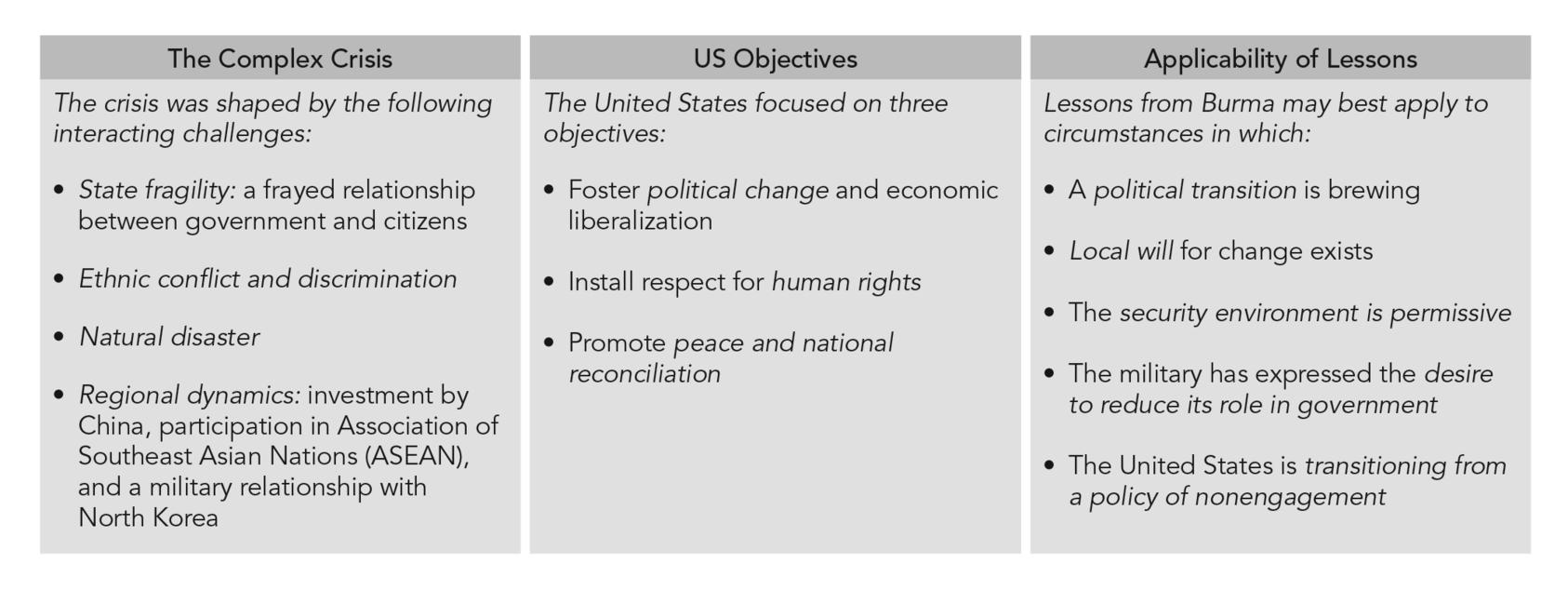
The US Defense, Development, and Diplomatic Response
Prior to 2009, the US government did not engage with Burma, instead sanctioning its leaders in an attempt to force regime change. Following a 2009 State Department policy review, the United States adopted a policy of “Action for Action,” responding to Burmese reforms with economic assistance, sanctions relief, senior leader engagement, and other forms of calibrated positive reinforcement. Although security sector assistance remained limited in light of the Burmese military’s involvement in politics and ongoing human rights abuses, the appointment of an ambassador and USAID mission director, and the launch of new programs and engagements (such as the jointly sponsored 3D Human Rights Dialogues featuring civilian and military officials) moved the relationship forward. The groundwork for success was laid by effective strategic planning both at home, through the use of a special representative and policy coordinator for Burma, and later in the field, through the creation of an integrated embassy process that set, communicated, and periodically reevaluated priorities. Close collaboration with Congress paved the way for more discretionary funding for the mission. Equipped with purpose-fit authorities, US government actors were able to engage opportunistically—for example, by helping ethnic armed groups attend peace negotiations. Effective communication helped organize 3D support and monitoring of the country’s 2015 elections, its freest and fairest ever.
Summary of Lessons from Burma
The case study review process yielded a series of lessons in three parts:
- A strategic planning process that knitted together the 3Ds in Washington, D.C., and in the field
- An “Action for Action” approach that allowed the 3Ds to customize their programs and responses to Burmese reform efforts
- A deliberate focus on building partnerships for progress, including between the executive and legislative branches, between the 3Ds; between Washington, D.C., and the field; and between the United States and international partners The following table summarizes these approaches, as well as some key takeaways.
Acknowledgements
This case study is the product of an extensive nine-month study that included a detailed literature review, stakeholder consultations in and outside of government, workshops, and a senior validation session. The project team is humbled by the commitment and sacrifices made by the men and women who serve the United States and its interests at home and abroad in some of the most challenging environments imaginable, furthering the national security objectives discussed herein. This project owes a significant debt of gratitude to all those who contributed to the case study process by recommending literature, participating in workshops, sharing reflections in interviews, and offering feedback on drafts of this docu-ment. The stories and lessons described in this document are dedicated to them. Thank you to the leadership of the United States Institute of Peace (USIP) and its Center for Applied Conflict Transformation for supporting this study. Special thanks also to the US Agency for International Development (USAID) Office of Transition Initiatives (USAID/OTI) for assisting with the production of various maps and graphics within this report. Any errors or omis-sions are the responsibility of the authors alone.
About the Authors
This case study was produced by a team led by Beth Ellen Cole, special adviser for violent extremism, conflict, and fragility at USIP, with Alexa Courtney, Erica Kaster, and Noah Sheinbaum of Frontier Design Group. Alexa and Noah previously directed the USIP-supported Fragility Study Group. Alexa has worked in USAID’s Office of Conflict Mitigation and Management, and Erica formerly served with USAID/OTI and the State Department’s Bureau of Conflict and Stabilization Operations. Noah’s work in the private sector brought additional insight into the project.
